BURGUNDY – LAND OF FINE ART AND FINE LIVING
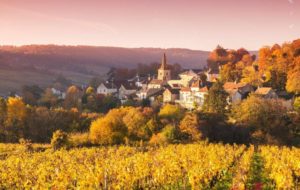
Burgundy is full of surprises and contrasts. Running from Auxerre in the north to Mâcon in the south, this is a vast and varied landscape of wide rivers, dense forests, granite hills, limestone valleys, meandering country lanes and rolling hillsides. Of course, even without all this beauty, the attractions that draw most visitors are the region’s wonderful food and world famous wines.
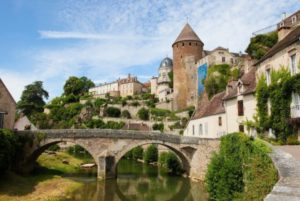
The ancient Celtic tribes, Romans, Cistercians and the powerful Dukes of Burgundy formed the towns and villages of Burgundy through the centuries. The region’s towns and its handsome capital, Dijon, are heirs to a glorious architectural heritage that goes back to the Renaissance and beyond to Celtic antiquity.
Feudal rule was imposed by the formidable dukedom of Burgundy, which at one time was a large empire that spread through eastern France, into Germany and up into Belgium and Flanders. At times, the dukedom was an enemy of the French crown and formed alliances with the English king, with a succession of Dukes holding a solid frontier, that nevertheless eventually became a French province under Louis XI, and finally joining the kingdom of France at the end of the 17th century.
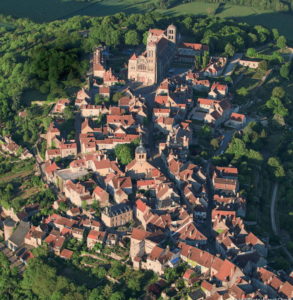
The power and influence of the Church in the region can be seen in the construction of a number of impressive abbeys and monasteries. The most important would have to be the Abbey at Vézelay near Avallon, which was founded in 868AD, and rebuilt in the 11th century as the Romanesque Basilica of Sainte-Marie-Madeleine. It is the starting point of one of the main pilgrimage routes to Santiago de Compostella.
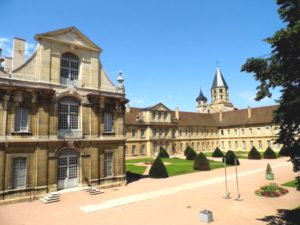
As well as this most important abbey church, now a UNESCO World Heritage Site, there are the remains of the Romanesque-style Benedictine abbey of Cluny—once the largest church in Christendom until St Peters in Rome was built.
Well worth checking out are a number of other huge religious complexes such as the abbeys of Pontigny (supposedly the biggest Cistercian Abbey in the world), Citeaux and La Bussiere built by the Cistercian and Benedictine orders.
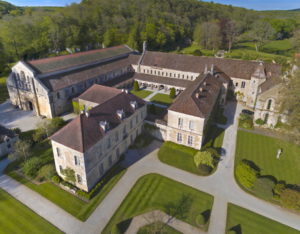
Not to be missed though is the great Cistercian abbey of Fontenay near Montbard, which is also a UNESCO World Heritage Site.
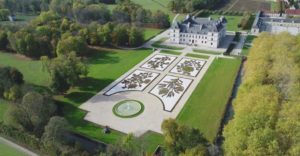
Dotted throughout the region are a number of other reminders of the Roman, Gothic and Renaissance eras including the châteaux of Ancey le Franc, Tanlay and the fortified chateau de Chateauneuf en Auxois.
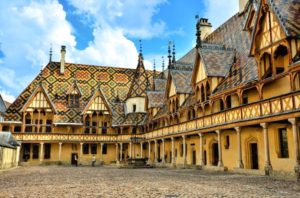
You can see many examples of the distinctive traditionally patterned, glazed roof tiles for which Burgundy is known, especially on the famous Hospices de Beaune, the old capital of Burgundy, and the roofs of majestic feudal estates like the Château de Santenay. This chateau is located between the Côte d’Or and Côte Chalonnaise, making this one of the largest wine domains in the Burgundy, making it well worth a visit.
Other châteaux with the traditional Burgundian roof tiles worth checking out include the Châteaux de Beaune, de la Rochepot, and de Corton-Andre.
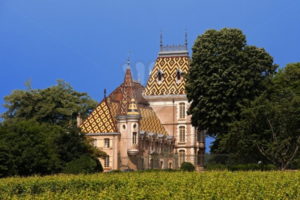
All these have renowned vineyards, welcome visitors and offer tastings.
Two great French passions, wine and food, unite here in a particularly enticing way. The hillsides of the Côte de Nuits and the Côte de Beaune were granted UNESCO World Heritage status on 04 July 2015, in recognition of the region’s centuries-old history of viticulture and the diversity of its winegrowing terroir. The Romans planted the first vines, although it was in the early Middle Ages that it really took off, firstly in the monasteries, but also in the châteaux of the duchy of Burgundy.
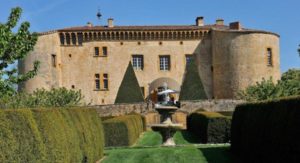
In fact, why not book a stay in a wine château? As well as producing its own wine, the Château de Bagnols, in the south of Macon, is also a hotel with a Michelin-starred restaurant, and with exciting extras such as hot air ballooning affording celestial views over the vineyards, and the local area.
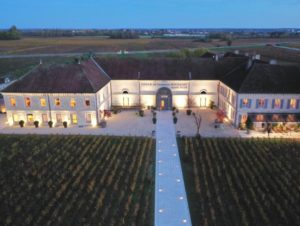
Château de Chassagne-Montrachet offers B&B accommodation, and is just 15 mins. from Beaune. Surrounded by vineyards, guests can enjoy private tours of the winery and cellar, and free wine-tastings.
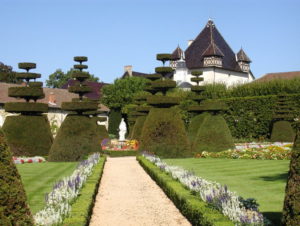
Another hotel chateau to check out is Château de Pizay, which strictly speaking is in Beaujolais territory. It has everything, including a gourmet restaurant, a high standard of accommodation, a spa, a pool and is surrounded by beautiful vineyards.
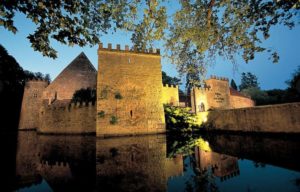
Although not a winery château, the recently restored Château de Vault de Lugny is quite special. Dating from 1120, (its 14th century dungeon is a classified Historic Monument), the Chateau is set in 40 hectares of gorgeous parkland just outside the village of Chablis, and not far from Vézelay.
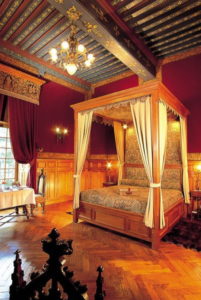
With its water-filled moat, the Chateau’s own farm, organic produce, including a truffle plantation, an animal refuge, meandering river, and best of all, a Michelin-starred gourmet restaurant and beautiful accommodation (many rooms with huge four-poster beds), it’s a perfect place to relax and explore all the nearby attractions.
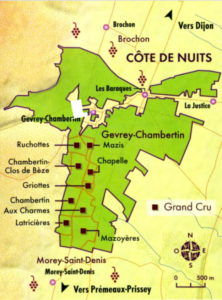
The world famous Burgundy vineyards produce some of the most prestigious and expensive wines in the world mostly from pinot noir and chardonnay grapes. The top wines are mostly produced on a narrow strip of land running south from Dijon on the western fringe of the Saône plain in the Côtes de Nuits and the Côtes de Beaune vineyard areas: revered names such as Gevrey-Chambertin, Romanée-Conti, Pommard, Volnay, Montrachet, Meursault, Clos de Vougeot, Savigny-les-Beaune, to name a few.
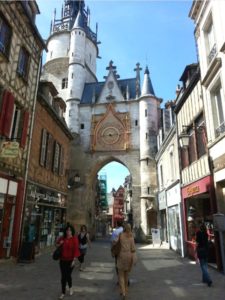
The Chardonnay styles in the Bourgogne winegrowing region stretch from Chablis, located midway between Beaune and Paris, and spread over 20 communes that produce the Chablis Grand Crus. The Grand Auxerrois area covers a multitude of very old, small plots, mostly to the south and southeast of medieval Auxerre.
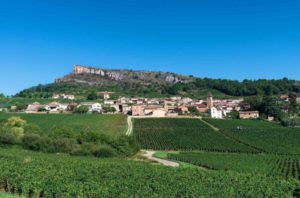
The village of Chardonnay that gave its name to this grape varietal is located in the Haut-Mâconnais, and the most famous of the Mâconnais Chardonnays are from around the Pouilly-Fuissé communes.
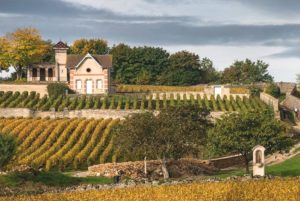
The Côte de Beaune Chardonnays tend to be from around Meursault. The great names include Montrachet, Puligny-Montrachet, Bâtard-Montrachet, Chassagne-Montrachet, and Corton-Charlemagne, to mention just some. It’s said that every plot in Burgundy has its own Chardonnay.
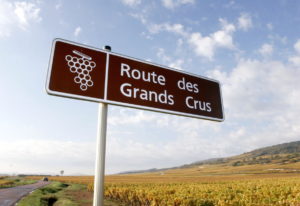
A great way to plan a visit through the Burgundy is by following the dedicated tourist route, the Route des Grands Crus, the quiet D122, a 60 km route that runs along the foot of the Côte d’Or escarpment from Dijon in the north to Santenay in the south. The Côte d’Or (Golden Slopes) is so named because of the incredible colour of the vine leaves that in autumn turn a bright yellow, like molten gold, stretching across the region’s east-facing vineyards.
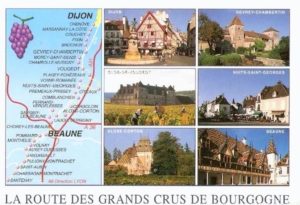
The Route des Grands Crus runs through many of the great appellations of Burgundy wine, hence the name of the route. It takes the visitor through the vineyards of the Côte de Nuits and the Côte de Beaune, and the back hills (Hautes-Côtes) behind and above the wine slopes. The Route is well marked and punctuated by 33 villages and little towns, including Beaune, many of which have picturesque churches and municipal buildings.
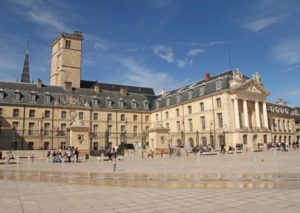
The two main towns of the Burgundy are Dijon, the region’s capital, and Beaune. Dijon is less than two hours on the TGV trains from Paris Gare de Lyon and there are lots of trains to choose from. But if you’d like to visit the Chablis area as well, consider taking the train from Paris-Bercy to Auxerre (Auxerre-St-Gervais is the station), which also takes well under 2 hours. It’s easy to rent a car from any of the main towns, which you’ll need to explore all charms of the region.
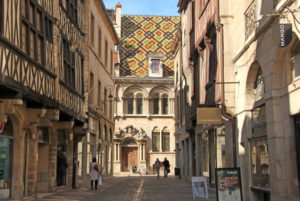
You’ll enjoy walking around the small city of Dijon, admiring its many elegant 17th century buildings, its famous Cathedral and the magnificent Palais des ducs de Bourgogne, now the Hotel de Ville. Dijon was the birthplace of Gustave Eiffel and home of Voltaire.
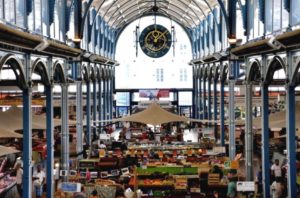
Not only is Dijon the home of the famous varieties of mustard, the entire area is a food lover’s heaven. The central market, Les Halles du Marché, is a dream location for finding the very best local seasonal produce. Depending on the time of year you visit, you’ll find Ruffey and Meursault asparagus, Burgundy truffles, crème de cassis, as well as fresh blackcurrants, snails, coq au vin, Boeuf Bourguignon, Bourguignonne Potée, Jambon persillé (very much a Burgundian specialty), regional cheeses such as Brillat-Savarin, Citeaux, Chaource, Epoisses, and any number of local chevre cheeses. And not forgetting wonderful dessert treats, especially the local gingerbreads and anything made with cassis. Note that the world famous International and Gastronomic Fair is held in Dijon every year in October, which is a wonderful opportunity to taste the cuisine and wines of France.
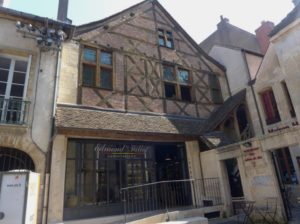
For devotees of mustard, the Edmond Fallot Moutarderie is a local institution. Founded around 1840, it’s the last family-run mustard factory in town. They offer tours of their factory and museum with mustard tastings at the conclusion. Google their website for details.
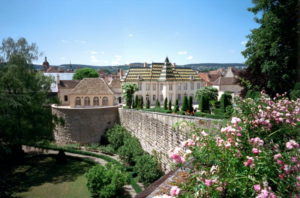
Forty kms south of Dijon, Beaune is one of the most delightful historic towns in the entire country, with some exceptional heritage sites to explore. Surrounded by about 2 kms of medieval ramparts, which you can walk around, it’s regarded as the centre of the Burgundy wine trade, as evidenced by the famous wine auction at the Hotel Dieu – Hospices de Beaune, held every 3rd Sunday in November. There are numerous beautiful Renaissance mansions to admire as you stroll around, as well as striking half-timbered houses and charming inner courtyards.
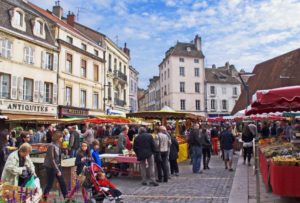
Although it’s quite compact, there’s so much of interest to see and do in Beaune, it’s a good idea to pop into the Tourist Bureau. You can book wine tours and there are audio guides available to ensure you won’t miss anything, allowing you to take it all in at your own pace. There are about 10 sites on these self-guided tours that can be downloaded via the multimedia terminals available around the town.
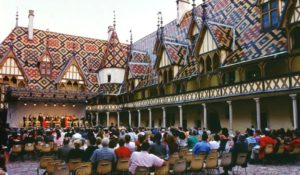
Beaune is also famous for its cultural activities. In July the Baroque Opera Festival and in September the Jazz Festival present international artists.
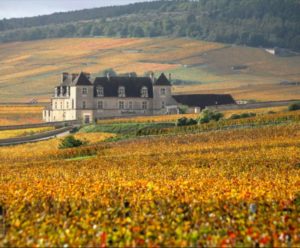
If you follow the Route des Grands Crus between Dijon and Beaune, you’ll pass many of the most famous wine villages of the region such as Nuits-Saint-Georges, and châteaux, including the magnificent 15th century Château du Clos de Vougeot, which is open to the public for tours.
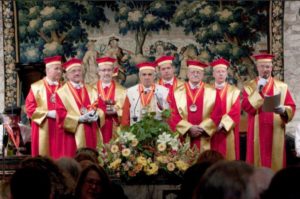
Owned by the Confrérie des Chevaliers de Tastevin, the château is also the venue for a series of classical music concerts featuring young artists called Musique et Vin au Clos Vougeot.
This is a region richly endowed with an abundance of attractions, ranging from food and wine, barge trips on the canals, hot-air ballooning, historic monuments and beautiful scenery. We’ll explore these and some of the smaller, less well-known sites and pretty villages in the next blog.
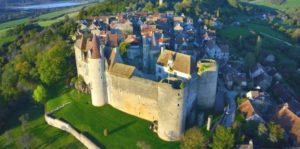

Cheryl Brooks
Thanks for your feedback. So glad you enjoyed reading about Burgundy–more to come soon!
Cheryl
Graham
Fantastic information. Can’t wait to get there.